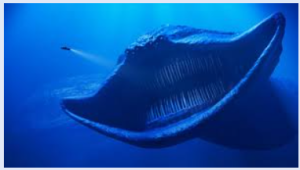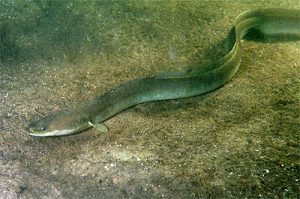Podcast: Play in new window | Download (Duration: 11:12 — 12.4MB)
Thanks to Murilo for suggesting El Gran Maja for our first monster month episode of 2024!
Further reading:
The Loch Ness Monster: If It’s Real, Could It Be an Eel?
Further watching:
Borisao Blois’s YouTube channel [I have not watched very many of his videos so can’t speak to how appropriate they all are for younger viewers]
El Gran Maja, YouTube star:

The European eel [photo by GerardM – http://www.digischool.nl/bi/onderwaterbiologie/, CC BY-SA 3.0, https://commons.wikimedia.org/w/index.php?curid=284678]:

A supposed 21-foot eel, a product of trick photography:

The slender giant moray eel [photo by BEDO (Thailand) – Own work, CC BY-SA 4.0, https://commons.wikimedia.org/w/index.php?curid=40262310]:

Show transcript:
Welcome to Strange Animals Podcast. I’m your host, Kate Shaw.
It’s monster month, where we talk about weird, mysterious, and sometimes spooky creatures! This year I’ve decided to be less spooky and more weird, so let’s kick off the month with an episode all about gigantic eels. Thanks to Murilo for suggesting our first giant eel, El Gran Maja.
El Gran Maja is an eel that is supposed to live off the coast of northern Puerto Rico, and it’s supposed to grow 675 meters long. That’s 2,215 feet, or almost half a mile. That is an excessive amount of eel.
Obviously, an eel that big couldn’t actually exist. By the time its front end noticed danger, its back end could already be eaten by a whole family of sharks. But maybe it was based on a real eel that grows really long. Let’s take a look at some eels we know exist, and then we’ll return to El Gran Maja and learn some very interesting things about it.
Eels are fish, but not every animal that’s called an eel is actually an eel. Some are just eel-shaped, meaning they’re long and slender. Electric eels aren’t actually eels, for instance, but are more closely related to catfish. Most eels live in the ocean at the beginning and end of their lives, and freshwater in between.
For example, the European eel has a life cycle that’s pretty common among eels. It hatches in the ocean into a larval stage that looks sort of like a transparent leaf. Over the next six months to three years, the larvae swim and float through the ocean currents, closer and closer to Europe, feeding on plankton and other tiny food. Toward the end of this journey, they grow into their next phase, where they resemble eels instead of leaf-shaped tadpoles, but are still mostly transparent. They’re called glass eels at this point. The glass eels make their way into rivers and slowly migrate upstream. Once a glass eel is in a good environment it metamorphoses again into an elver, which is basically a small eel. As it grows it gains more pigment until it’s called a yellow eel. Over the next decade or two it grows and matures, until it reaches its adult length—typically around 3 feet, or about a meter. When it’s fully mature, its belly turns white and its sides silver, which is why it’s called a silver eel at this stage. Silver eels migrate more than 4,000 miles, or 6500 km, back to the Sargasso Sea to spawn, lay eggs, and die.
One place where European eels live is Loch Ness in Scotland, and in the 1970s the idea that sightings of the Loch Ness Monster might actually be sightings of unusually large eels became popular. A 2018 environmental DNA study brought the idea back up, since the study discovered that there are a whole, whole lot of eels in Loch Ness. The estimate is a population of more than 8,000 eels in the loch, which is good since the European eel is actually critically endangered. But most of the eels found in Loch Ness are smaller than average, and the longest European eel ever measured was only about 4 feet long, or 1.2 meters.
An eel can’t stick its head out of the water like Nessie is supposed to do, but it does sometimes swim on its side close to the water’s surface, which could result in sightings of a string of many humps undulating through the water.
But the Loch Ness monster aside, the European eel isn’t very big compared to many species of eel. The European conger eel is the heaviest eel known, although not the longest. It lives off the coast of Europe down to northern Africa, and also in the Mediterranean Sea. An exceptionally large female might be as much as 10 feet long, or 3 meters, but it’s also chonkier than other eels. The largest conger ever measured reportedly weighed 350 lbs, or almost 159 kg, and was caught in a net off the coast of Iceland, although that report isn’t very reliable.
In 2015, a lot of newspaper reports talked about a huge eel caught off the coast of Devon, England. They printed pictures of a massively huge eel hung up in front of the fishermen who caught it. The articles said the eel was as much as 21 feet long, or 6.4 meters, and weighed 160 lbs, or just over 72 kg.
But if you think about it, there’s something fishy (sorry) about the story. If you picture a big man, say a football player who’s fit and strong, he might be about six feet tall, or 1.8 meters, and weigh a bit more than 200 lbs, or maybe 95 kg. But the eel weighed a lot less than that hypothetical man, and eels are strongly muscled even though they’re slender in shape. A 21 foot eel should weigh much more than a football player.
Most likely, reporters looked at the photo and compared it to the fishermen, and came up with the 21 foot length themselves. But it’s a trick photo, even if the trick wasn’t planned, because the eel was hung up very close to the camera while the fishermen were much farther back, which makes the eel look huge in comparison. Not only that, but when you hang a dead eel up by its head, it stretches so that it looks longer than it really was when it was alive. Other pictures of the eel make it look much shorter.
As it turns out, the fishermen who caught the eel didn’t even measure it. They thought it might have been up to 10 feet long, but it might have been closer to 7, or 2 meters. That’s still a big eel, and the weight may be close to a reliable record of heaviest eel, but it’s nowhere near the longest eel ever measured.
That record goes to the slender giant moray eel, which lives in muddy coastal water of the Pacific Ocean. It’s brown and isn’t especially exciting to look at unless you’re an eel enthusiast or an actual eel yourself, but the longest eel ever reliably measured was a slender giant moray. That was in 1927 in Queensland, Australia. The eel measured just shy of 13 feet long, or 3.94 meters.
In other words, the longest eel ever measured is approximately 2,202 feet, or 671 meters, shorter than El Gran Maja. But to learn more about El Gran Maja we have to talk about something called the bloop.
The bloop is a sound recorded in 1997 off the tip of South America by the National Oceanic and Atmospheric Administration, AKA NOAA. The sound itself came from the middle of the South Pacific Ocean, and was so loud that it was recorded by sensors 3,000 miles away, or 5,000 km. But it was also an ultra-low-frequency sound, so that humans and most other animals wouldn’t be able to hear it at all.
This is what the bloop sounds like, sped up 16 times so that people can hear it:
[bloop sound]
It turns out that the bloop was made by a big iceberg breaking into pieces, and similar sounds have been recorded since by NOAA and other researchers. But when the bloop was first made public, its source was still a mystery, and pretty much everyone on the internet lost their minds with excitement thinking it was a deep-sea creature far bigger than a blue whale. People speculated about the size of the bloop monster and estimated it had to be about 705 feet long, or 215 meters, for it to make such a loud call.
A film-maker and artist named Borisao Blois was interested in the bloop monster and wanted to animate it, but decided it needed a rival to fight—and he wanted the rival to be even bigger. He invented El Gran Maja and animated a fight between the two. Because Blois wanted his monster to be exciting to look at during his films, he gave it a huge wide mouth filled with sharp, comb-like teeth, and six all-white eyes. The first video was released in 2001 and has more than 89 million views. Many more videos followed, along with creations made by other artists who were inspired by the original.
The videos Blois has made about El Gran Maja are popular, and some people even think it might be a real monster. Considering that an eel that big would need to eat an astounding amount of food every day to survive, and it’s big enough to swallow entire ships whole, it’s probably a good thing that it’s just a made-up monster.
You can find Strange Animals Podcast at strangeanimalspodcast.blubrry.net. That’s blueberry without any E’s. If you have questions, comments, or suggestions for future episodes, email us at strangeanimalspodcast@gmail.com. We also have a Patreon at patreon.com/strangeanimalspodcast if you’d like to support us for as little as one dollar a month and get monthly bonus episodes.
Thanks for listening!